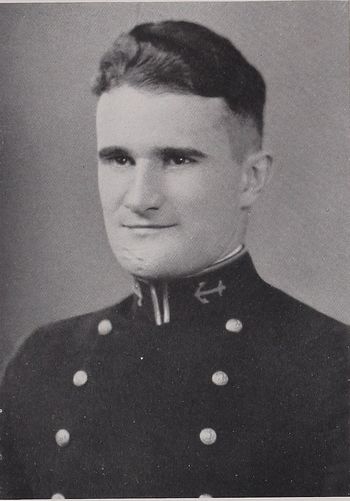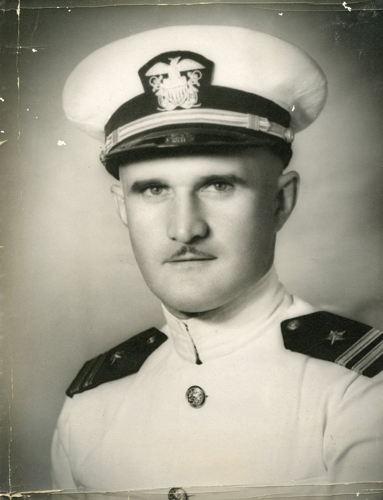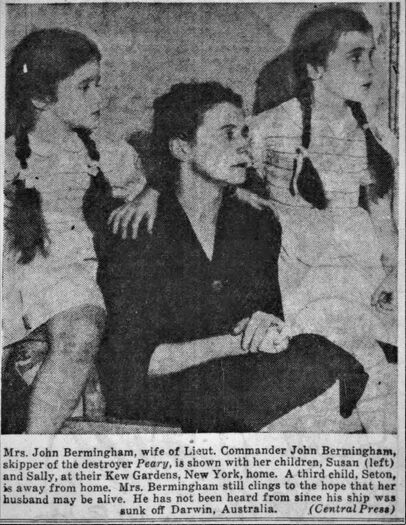JOHN M. BERMINGHAM, LCDR, USN
John Bermingham '29
Lucky Bag
From the 1929 Lucky Bag:
JOHN MICHAEL BERMINGHAM
New York City, New York
"Juno"
JUNO has two respects in which he differs from the rest of the Regiment. The first is a delusion that the textbooks "prepared especially for the use of Midshipman at the United States Naval Academy" contain matter that should be remembered. To that end he concocts strange combinations of syllables such as bompheanilsloshvacku and ordulastiptop—key words, if you please, to make it next to impossible to forget the various kinds of projectile or the consideration in selecting airfoil. An excellent idea if there were only a way to insure against the regrettable blunder of using an Ordnance keyword in a Steam exam. The second is a preference for recognition in literature rather than athletics, an ambition that he considers will be realized with the twelfth rejection slip.
Otherwise he is a normal midshipman, breaks hearts with a mechanical method that savors of repetition, and says, "Now, when I was a Plebe" and the "Navy has gone to the dogs" in the proper disgusted tone. He is distinctive for a minimum of false pride, for an enviable unflagging interest in all he does, and for a passion for thoroughness, characteristics that augur well for success.
Glee Club 4, 3, 2; Gymkhana 4, 3, 2; Orchestra 2, 1; Trident Magazine 2, 1; Trident Society 2, 1; 1 P.O.

JOHN MICHAEL BERMINGHAM
New York City, New York
"Juno"
JUNO has two respects in which he differs from the rest of the Regiment. The first is a delusion that the textbooks "prepared especially for the use of Midshipman at the United States Naval Academy" contain matter that should be remembered. To that end he concocts strange combinations of syllables such as bompheanilsloshvacku and ordulastiptop—key words, if you please, to make it next to impossible to forget the various kinds of projectile or the consideration in selecting airfoil. An excellent idea if there were only a way to insure against the regrettable blunder of using an Ordnance keyword in a Steam exam. The second is a preference for recognition in literature rather than athletics, an ambition that he considers will be realized with the twelfth rejection slip.
Otherwise he is a normal midshipman, breaks hearts with a mechanical method that savors of repetition, and says, "Now, when I was a Plebe" and the "Navy has gone to the dogs" in the proper disgusted tone. He is distinctive for a minimum of false pride, for an enviable unflagging interest in all he does, and for a passion for thoroughness, characteristics that augur well for success.
Glee Club 4, 3, 2; Gymkhana 4, 3, 2; Orchestra 2, 1; Trident Magazine 2, 1; Trident Society 2, 1; 1 P.O.
Loss
John was lost when USS Peary (DD 226) was sunk in Darwin harbor, Australia, by Japanese air attack on February 19, 1942. There is an extensive history of the ship's brief wartime career, beginning with the air raid at the Cavite Navy Yard, Philippines, on December 10, 1941 and including her harrowing escape to Australia.
Biography
From Military Hall of Honor:
After his graduation, Ensign Bermingham reported to his mandatory sea-duty tour on board the battleship, USS Wyoming (BB-32) on 13 July 1929. About a year later, Ens. Bermingham took leave to marry Mary Grace Joyce, daughter of Hubert Joseph “Hugh” and Sarah Theresa Lucas Joyce, on 09 Aug 1930 in Bronx, NY. During the 1930s, Bermingham served under instruction as a student pilot at the Naval Air Station, Pensacola, FL, (he didn’t earn his wings) then on to the destroyer USS Ellis (DD-154) during which his first child, a daughter named Sarah, was born on 01 Jun 1932 in NYC. A few days later, he was promoted to Lieutenant Junior Grade (Ltjg) on 06 Jun 1932.
That assignment was followed by a short tour of temporary duty at the Naval Training Station, Norfolk, VA. His next assignments were consecutive tours of duty on board destroyers USS Taylor (DD-94); USS McFarland (DD-237); and USS Hatfield (DD-231). Those tours were followed by a relatively short tour on board the battleship, USS Utah (BB-31). Just prior to detaching from Utah, the Berminghams welcomed their second child, Susan Joyce, born in NYC on 16 April 1936. In July 1936, Ltjg Bermingham was assigned as an instructor at the US Naval Academy in Annapolis, MD (Naval Academy Register, 1937). During his 3 year tour of duty at Annapolis, Bermingham was promoted to Lieutenant (Lt) on 30 Jun 1937.
Lt Bermingham received orders on 27 July 1939 to report to Asiatic Station for assignment. In Oct 1939, he reported on board the heavy cruiser, USS Augusta (CA-31) flagship of the Asiatic Fleet. Lt Bermingham became a father for the third and last time when daughter, Elizabeth B., was born on 12 Nov 1939 in Manhattan, NY.
Lt Bermingham received orders dated 23 Jan 1940 to detach from Augusta and report to the flush-deck destroyer, USS Stewart (DD-224), as her executive officer. Stewart entered the Cavite Navy Yard for overhaul on 05 April 1940 shortly after Lt Bermingham reported on board. Upon leaving the yard on 1 June, Stewart acted as plane guard vessel for seaplanes flying between Guam and the Philippines and then made a final tour of Chinese Yellow Sea ports from 7 July to 23 September 1940 as international tensions increased. Units of the Asiatic fleet would remain in the Philippines until Nov 1941.
From Wikipedia:
In 1940, Bermingham was appointed executive officer of destroyer USS Stewart (DD-224). At the outbreak of war with Japan, on 7 December 1941, Bermingham was on his way home for leave. During the first Japanese attack on Cavite, Philippines, on 10 December, the commanding officer of the destroyer USS Peary (DD-226), H.H. Keith, was wounded. Bermingham was ordered to take command on 11 December 1941.
The ship was assigned to offshore patrol and came under heavy air attack many times in the following days. Excellent seamanship during bombing and torpedo attacks 26 and December 27 saved her from destruction.
Despite Japanese air superiority, Bermingham succeeded in bringing his ship to Darwin, Australia, to operate with American-British-Dutch-Australian Command naval forces attempting to hold the "Malay Barrier". Peary operated with the cruiser USS Houston (CA-30) in early February.
In mid-February, Peary was part of an unsuccessful attempt to resupply Allied forces under attack on Timor. She was anchored at Darwin when the Japanese attacked in a massive bombing raid on 19 February 1942. Bermingham got his ship underway and attempted to maneuver in the restricted waters; but, despite valiant antiaircraft fire, his ship was hit with five bombs. Bermingham and about 80 of his crew went down with the ship.
There is a photo of his widow and two of his three daughters taken shortly after his death was known to them.
Photographs
Other Information
From researcher Kathy Franz:
John attended parochial schools in New York and attended Manhattan College for one year.
He married Grace Joyce (Hastings) in Manhattan on August 9, 1930. In December 1940, his wife and their children, Sally, Susan and Seton, were evacuated from China.
On January 1, 1942, he was promoted to lieutenant commander.
His father Daniel was a New York City municipal worker. His mother was Annie, and sisters were Veronica (Mrs. James J. Flanagan) and Susan (Mrs. Philip B. Preston.) In 1910, his father was a driver of a dry goods wagon. John’s parents were both born in Ireland.
Shipmate
From the May 1942 issue of Shipmate:
John Bermingham's Tour of Duty is Finished
By H.V.WILEY, '15
December 1, 1941. John Bermingham's tour of duty on the Asiatic Station was finished. He had served his full "cruise" in the Far East, had been detached from duty as executive officer of one of the most efficient destroyers of the 29th Squadron. Two divisions of the squadron had departed "on a practice cruise." The other division of four ships was still in Manila, one pair completing a routine Navy Yard overhaul, the other pair waiting to replace them a week or two later.
December 7, 1941. John Bermingham, his tour of duty finished, was in Manila waiting for transportation home. Over came the Japanese bombers and the war was begun. The bombing was not heavy in Manila at first, as military targets, particularly air-fields, were sought. John watched the attacks, as he was not on duty and he had little to do. On Wednesday he looked across Manila Bay and saw the Navy Yard at Cavite attacked. One of the first victims was the destroyer Peary, which was completing overhaul, the Yard and the crew working desperately to get the engines together, the guns and torpedoes on board. The Peary was hit on the top of the bridge by a large bomb filled with gasoline, concrete, steel scrap, and perhaps shrapnel. Down went the foremast; down went the Captain, injured; down went the Executive Officer dead; down went the Engineer Officer, injured, and down went ten to twenty of the gallant crew—never to rise again. Two days later the torpedo officer had the ship in the harbor under steam, skillfully dodging the sticks of bombs dropped on him.
December 14, 1941. John Bermingham, his tour of duty finished, visited the Navy Yard to again inquire about means of transportation or of returning to duty. A Commander passed him in the Yard, then halted him and asked if he were not a destroyer officer, and upon receiving an affirmative answer ordered him to board the Peary and take command. Meanwhile the ship had assembled thirty men of various ratings in the Navy Yard to replace the killed, wounded and missing of her crew. John Bermingham went to work, organizing and drilling the crew, fitting out with ammunition, charts, a spar for a mast, a radio transmitter, fuel, provisions, anything that could be gotten at night when the ship could come to a dock while the bombers were not around. Some of the holes were patched in the decks, but the bow which was being replaced had to be left open to the sea in many places, and the plates above water were only bolted in place. The Peary then commenced escort duty and other missions as required.
Late December, 1941. John Bermingham's tour of duty in Manila Bay was finished. Enemy forces were about to occupy Manila. At night at the Naval Base John Bermingham saw the Commandant and was told to "go on south." An hour later he was steaming through the mine-fields, and into the open China Sea, with no prescribed route or destination. Bombing planes were active in many sections of the Philippines. John Bermingham was on his own.
How he got through can not be published at this time, except to say that his ingenuity and fortitude were remarkable. He evaded enemy cruisers and submarines; he was bombed by the enemy; he was bombed by friends who did not know that an Allied ship was in those waters. Ammunition was set on fire. One man stationed aft and a man at a machine gun was killed on the bridge. Another was lost overboard during action. Finally, about out of fuel, food and water he reached a small friendly port where he got enough supplies to go on.
Early January, 1942. John Bermingham's duty was finished. He reached a port where some of his own Navy was present. His bedraggled-looking ship, the smoke stacks full of holes, the bridge half gone, no mast except a boat spar, camouflaged in various ingenious ways, had reached a haven. However, another enemy was at work. Twenty-five men and officers were transferred to the hospital with malignant malaria and within three days five had died. Again a replacement crew was received. The ship was provisioned and repaired. In a few days the Peary was again at sea on war missions. One mission was particularly dangerous as it included taking supplies to a port that was being bombed daily.
Late February, 1942. John Bermingham's tour of escort duty was finished. He had undergone two bombings during the voyage. He returned to port for fuel about 8 a.m. At about 1100 a terrific bombing attack, the first suffered by that port, came without warning. The Peary was hit aft immediately and a fire was started. The next hit was amidships and the ship started sinking. A few minutes later a bomb hit near the bridge and pierced the magazines of the thin-shelled ship. As she sank the guns above water amidships were still firing fiercely.
Brave, competent John Bermingham's tour of duty was finished. The few survivors of his crew revere and honor him as do we all.
John Michael Bermingham, '29. R. I. P.
From Hall of Valor:
The President of the United States of America takes pride in presenting the Navy Cross (Posthumously) to Lieutenant Commander John Michael Bermingham (NSN: 0-62695), United States Navy, for extraordinary heroism and distinguished service in the line of his profession as Commanding Officer of the Destroyer U.S.S. PEARY (DD-226), during operations in enemy waters of the Philippine Islands and later Dutch Timor waters during the period from 10 December 1941 to 19 February 1942. After Manila Bay became untenable as an operating base, Lieutenant Commander Bermingham piloted his vessel to Darwin, N.T, Australia, narrowly escaping by his skillful maneuvering the attacks of bombers and torpedo planes on one occasion and avoiding further attacks during daylight by ingeniously camouflaging and hiding his ship near land. He later carried out a second hazardous mission in delivering gasoline to an airfield which was under continual enemy surveillance. His action and good judgment not only saved his ship in the first instance but also ensured the successful accomplishment of others. During the bombing of Darwin, Australia, by approximately 80 enemy aircraft he fought his ship valiantly against continued dive bombing attacks and went down with the U.S.S. PEARY when she finally sank. Lieutenant Commander Bermingham's inspiring leadership and the valiant devotion to duty of his command reflect great credit upon himself and are in keeping with the finest traditions of the United States Naval Service. He gallantly gave his life for his country.
General Orders: Commander in Chief, Pacific: Serial 02457 (November 23, 1942)
Service: Navy
Rank: Lieutenant Commander
Namesake
USS John M. Bermingham (DE 530) was named for John; the ship was sponsored by his widow.
The "Register of Commissioned and Warrant Officers of the United States Navy and Marine Corps" was published annually from 1815 through at least the 1970s; it provided rank, command or station, and occasionally billet until the beginning of World War II when command/station was no longer included. Scanned copies were reviewed and data entered from the mid-1840s through 1922, when more-frequent Navy Directories were available.
The Navy Directory was a publication that provided information on the command, billet, and rank of every active and retired naval officer. Single editions have been found online from January 1915 and March 1918, and then from three to six editions per year from 1923 through 1940; the final edition is from April 1941.
The entries in both series of documents are sometimes cryptic and confusing. They are often inconsistent, even within an edition, with the name of commands; this is especially true for aviation squadrons in the 1920s and early 1930s.
Alumni listed at the same command may or may not have had significant interactions; they could have shared a stateroom or workspace, stood many hours of watch together… or, especially at the larger commands, they might not have known each other at all. The information provides the opportunity to draw connections that are otherwise invisible, though, and gives a fuller view of the professional experiences of these alumni in Memorial Hall.
July 1929
October 1929
January 1930
April 1930
January 1931
LT Paul Thompson '19
LT Irving Wiltsie '21
LTjg Matthias Marple, Jr. '23
LTjg Robert Larson '24
LTjg James McDonough '24
LTjg John Waldron '24
LTjg Charles McDonald '24
LTjg Richard Moss '24
LTjg John Duke '26
April 1931
LT Irving Wiltsie '21
LTjg Matthias Marple, Jr. '23
LTjg Robert Larson '24
LTjg James McDonough '24
LTjg John Waldron '24
LTjg Charles McDonald '24
LTjg Richard Moss '24
LTjg John Duke '26
LTjg James Averill '27
LTjg William Potts '27
October 1932
January 1933
April 1933
April 1934
July 1934
October 1934
January 1935
April 1935
October 1935
January 1936
April 1936
July 1936
January 1937
April 1937
LTjg Victor Gaulin '30 (Training Plane Squadron (VN) 8D5, Naval Academy)
September 1937
LT Robert Bedilion '22
LT William Hobby, Jr. '23
LT Richard Baron '24
LT Richard Gingras '25
LT Harold Pound '25
LT William Graham, Jr. '25
LT Andrew Harris '25
LT Ralph Hickox '27
LTjg Egbert Roth '29
January 1938
LT Robert Bedilion '22
LT William Hobby, Jr. '23
LT Richard Baron '24
LT Richard Gingras '25
LT Harold Pound '25
LT William Graham, Jr. '25
LT Andrew Harris '25
LT Ralph Hickox '27
LT Egbert Roth '29
July 1938
LT William Hobby, Jr. '23
LT Richard Baron '24
LT Harold Pound '25
LT William Graham, Jr. '25
LT Andrew Harris '25
LT Hilan Ebert '26
LT Egbert Roth '29
LT Victor Gaulin '30
LTjg Russell Ross '30
LT John Bisson '30
LTjg Raymond Mayo '30
January 1939
LCDR Robert Bedilion '22
LCDR William Hobby, Jr. '23
LT Richard Baron '24
LT Harold Pound '25
LT William Graham, Jr. '25
LT Andrew Harris '25
LT Hilan Ebert '26
LT Egbert Roth '29
LT Victor Gaulin '30
LT Russell Ross '30
LT John Bisson '30
October 1939
June 1940
November 1940
April 1941

The "category" links below lead to lists of related Honorees; use them to explore further the service and sacrifice of alumni in Memorial Hall.

